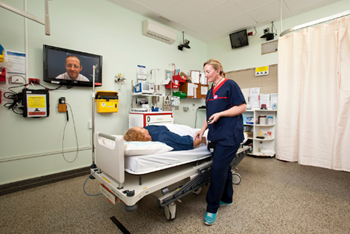Emergency Telehealth Service
 The Emergency Telehealth Service (ETS) supports WA country doctors and nurses by providing 24/7 access to specialist emergency clinicians by videoconference to more than 90 small hospitals and nursing posts around the state.
The Emergency Telehealth Service (ETS) supports WA country doctors and nurses by providing 24/7 access to specialist emergency clinicians by videoconference to more than 90 small hospitals and nursing posts around the state.
Keeping care closer to home and ensuring equity of access for country communities, the service provides access to specialist emergency care in regional and remote health centres across country WA.
Thanks to ETS, regional and remote patients now have access to emergency medicine specialists like metropolitan patients, when they need it. Nearly 250,000 patient consultations have been conducted through ETS since it was introduced 2012.
ETS uses high-definition videoconferencing technology to link doctors and nurses in rural and remote sites to specialist emergency doctors and nurses who assist with the diagnosis, treatment, and transfer of critically ill and injured emergency patients.
It is particularly valuable if there is no on-call doctor available to smaller regional hospital sites and nurses need to access a doctor.
The service provides a greater level of medical support to regional areas and helps build knowledge and expertise of all regional clinical staff by supporting their professional development and reducing their professional isolation.
See how the service works in the following scenarios:
The ETS is predominantly staffed by Fellows of the Australasian College for Emergency Medicine (FACEMs) who have extensive training and expertise in examining, diagnosing, and treating emergency patients. And experienced Clinical Nurses with advanced nursing skills and knowledge in critical care to facilitate safe, timely and effective emergency care of patients.
The service also has a number of non-specialist doctors, generally GPs or other medical officers and Nurse Practitioners, who have extensive emergency department experience and have previously worked in WA Country Health Service.
We also provide educational and upskilling opportunities for nurses and GPs working in rural emergency departments using a ‘virtual classroom’ to run state-wide education and simulation sessions.
The telehealth equipment includes a video screen and remote-controlled camera, so the ETS clinician can use it to zoom in on a patient.
ETS equipment is also installed in resuscitation bays at participating country hospitals or nursing posts.
It enables the ETS clinician to examine and talk to patients, and to guide local clinical staff in physical examinations and specialist emergency treatments.
Download a map of current ETS sites in regional WA and the proposed sites.

